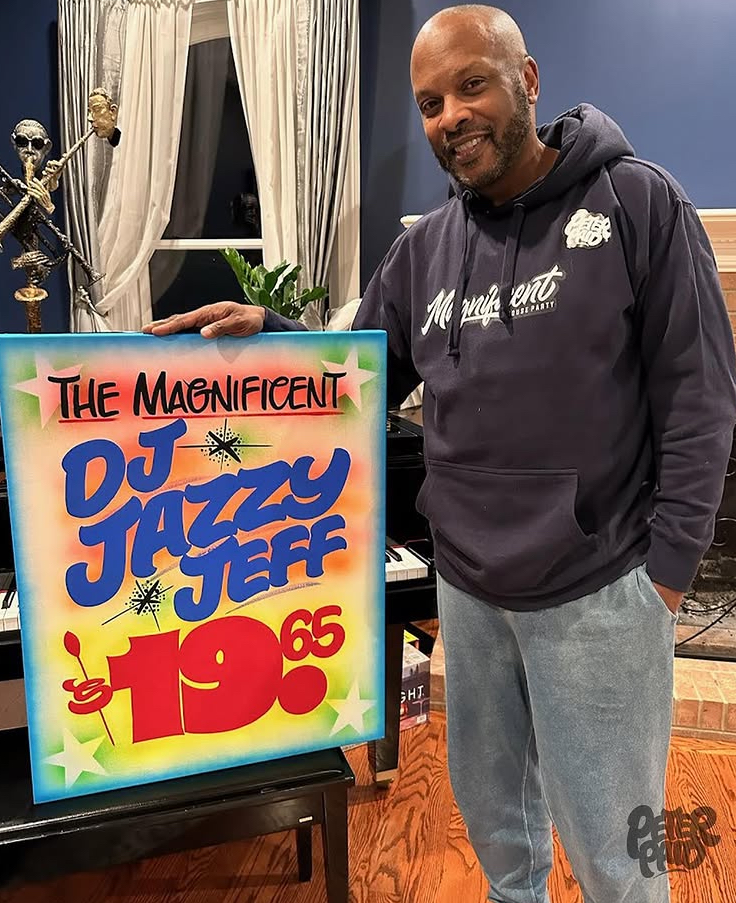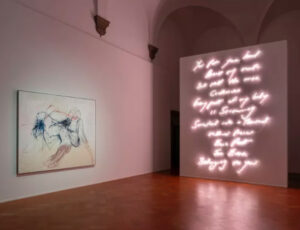“I never wanted to just ride the wave—I wanted to help build the tide.” — DJ Jazzy Jeff
In a warm domestic interior—somewhere between personal studio and art salon—DJ Jazzy Jeff stands casually beside a radiant piece of visual artwork that says far more than the sum of its shapes, colors, or letters. The painting he proudly gestures to is an explosion of type, gradient, and generational tribute: a vivid, hand-painted piece by the artist Peter Paid, emblazoned with the declaration:
“THE MAGNIFICENT DJ JAZZY JEFF $19.65”
It’s more than artwork. It’s a cipher. It’s a poster for a party that may never end. It’s a timestamp of influence. And at its center stands one of the architects of hip-hop’s mainstream transcendence—Jeffrey Allen Townes, better known as DJ Jazzy Jeff.
A Moment Captured: Not Just A Portrait, But A Portal
At first glance, this image offers the aesthetic satisfaction of clean visual storytelling: Jeff, hoodie-clad and smiling, his hand resting with familiarity and pride on the edge of the artwork. Behind him, an upright piano with clean keys. A hardwood floor soaked in amber warmth. A skeletal sculpture, possibly an abstract metaphor for the lives behind the music. Curtains drawn in a cozy twilight. Everything is still—except the colors of the sign, which radiate with movement.
Peter Paid’s work doesn’t hang so much as it pulses, its neon-bright letters recalling the mixtape era, barbershop price signs, roller rinks, and hand-painted marquees that once populated the creative corners of cities like Philadelphia, Chicago, and New York. This piece fuses the nostalgia of hip-hop’s analog origins with the boldness of contemporary street signage.
But this image is not about nostalgia. It’s about continuity.
The Typography of Tribute
The typography in Paid’s artwork is unmistakably deliberate. The font recalls 1980s block party flyers—the ones Xeroxed onto telephone poles, the ones that turned basketball courts into dance floors. Each letter in “DJ JAZZY JEFF” is curved and colored with intention, almost cartoonish in its buoyancy, channeling the animated flair of early hip-hop graphics: Yo! MTV Raps, graffiti murals, record crates marked in Sharpie.
The “$19.65” is arguably the central motif. On one level, it’s playful—appearing almost like a price tag, a satirical jab at the commodification of legacy. On another, it’s a code: Jeff was born in 1965, the same year Malcolm X was assassinated, the Voting Rights Act was passed, and the seeds of hip-hop culture were beginning to be sown in African-American neighborhoods through soul, jazz, and spoken word traditions.
In the context of this piece, $19.65 becomes a symbol—not of cost, but of origin.
Peter Paid: The Visual MC of Street Ephemera
If DJ Jazzy Jeff turns sound into sculpture, Peter Paid transforms commercial signage into visual jazz.
His practice revolves around elevating lowbrow aesthetics—deli signs, discount ads, shipping labels—into icons of cultural commentary. Trained in the lineage of graffiti, Paid’s canvas often explores the tension between utility and expression. He is as influenced by subway tags as he is by store marquees, as reverent of hand-lettered tradition as he is experimental in execution.
This collaboration with Jazzy Jeff is emblematic of that ethos. It’s a graffiti-adjacent, bodega-familiar, pop-art explosion, imbued with a level of polish that belies its streetwise swagger.
By incorporating gradients, halftones, stars, and playful spacing, Paid creates visual rhythm—not unlike scratching vinyl. It’s not hard to imagine the piece speaking in percussive beats: THE… MAG-NI-FI-CENT… DJ… JAZ-ZY… JEFF… ka-ka-ka—$19.65!
DJ Jazzy Jeff: Hip-Hop’s Sonic Architect
Before the Grammys. Before the charts. Before “Parents Just Don’t Understand” and The Fresh Prince of Bel-Air, there was a teenage turntablist in West Philadelphia, slicing breakbeats with surgical precision and treating Technics 1200s like a concert piano. DJ Jazzy Jeff was never just a sidekick to Will Smith’s stardom—he was an innovator, a technician, and a preservationist of DJ culture.
He revolutionized the transformer scratch, created one of the first hip-hop duos to win a Grammy (1989, for Best Rap Performance), and helped bring DJ performance into households across the globe. Even after the sitcom era faded, Jeff continued touring, producing, and mentoring, helping young producers understand the foundations of beatmaking, crate-digging, and analog fidelity in a digital world.
In many ways, this artwork is his scoreboard—not of wins, but of legacy. Peter Paid doesn’t paint an artist frozen in time; he paints a time that keeps moving with the artist.
Color as Culture: A Palette Rooted in Rhythm
Look closely at the gradients: the sign glows with hues of aquamarine, scarlet, tangerine, and mint green, evoking the fluorescent glow of block party nights and neon storefronts. The stars dotted across the composition aren’t decoration—they’re echoes of the party flyers from the Bronx, Brooklyn, South Philly, and the South Side of Chicago, where hip-hop’s earliest advertisements were acts of typography as much as community invitation.
These choices transform the visual into auditory memory. The blues and reds don’t just pop—they hum. The stars aren’t still—they fizz with breakbeats.
Just as Jeff’s scratching bends sound into narrative, Paid’s gradients blur visual boundaries, suggesting that memory, culture, and legacy don’t exist in boxes—they bleed, like ink on newsprint or sound leaking from headphones.
Clothing as Continuity: The “Magnificent” Thread
DJ Jazzy Jeff’s hoodie reads “Magnificent”, a direct nod to his 2002 album The Magnificent—his first solo studio project after decades of duo fame. That album was an inflection point, where Jeff reclaimed his artistic autonomy, worked with emerging talent like Jill Scott, and showcased his gift for fusing jazz, soul, and classic hip-hop into a mature, genre-defiant sound.
Wearing that word now—Magnificent—is not just branding. It’s reclamation.
It suggests that legacy doesn’t rest on nostalgia. It evolves. It matures. It returns, not as memory, but as material.
Environment as Echo: Domestic Space as Creative Shrine
This isn’t a gallery. It isn’t a museum. It isn’t a DJ booth. It’s a home—and that matters.
The piano behind Jeff whispers of composition. The hardwood floor speaks of lived rhythm. The sculpture—an abstract humanoid skeleton, part jazzman, part trickster—feels like a nod to the ghosts of past collaborators and ancestors whose voices still echo in vinyl grooves and mic reverb.
This room is not curated; it is lived-in. Which makes the artwork not promotional, but personal.
In choosing to display Peter Paid’s piece here—beside instruments, symbols, and silence—Jeff invites us to view it not just as fan art, but as biography.
Legacy as Currency: What Does $19.65 Buy You?
On one level, the $19.65 graphic is tongue-in-cheek—a nod to hip-hop’s frequent flirtation with money, from Paid in Full to gold chains. But on another, it provokes a question:
What is the worth of a legacy?
Is it measured in units sold? Streams? Plaques? Or is it in moments like this—quiet, joyful, art-filled—where one of the genre’s originators receives his roses not from the industry, but from a visual storyteller fluent in the same language?
Peter Paid doesn’t inflate the number. He doesn’t frame it in gold. He paints it with humor, reverence, and style—just like hip-hop itself.
Impression
In a time when much of hip-hop’s past is either commodified or forgotten, this image stands as a powerful refusal. It doesn’t just document a man and his art. It documents a philosophy.
That legacy is not static. That art is intergenerational. That culture survives through collaboration, respect, and reinvention.
Peter Paid and DJ Jazzy Jeff aren’t just artist and subject. They are co-conspirators in preservation, preserving the soul of a culture that has always painted outside the lines.
No comments yet.







